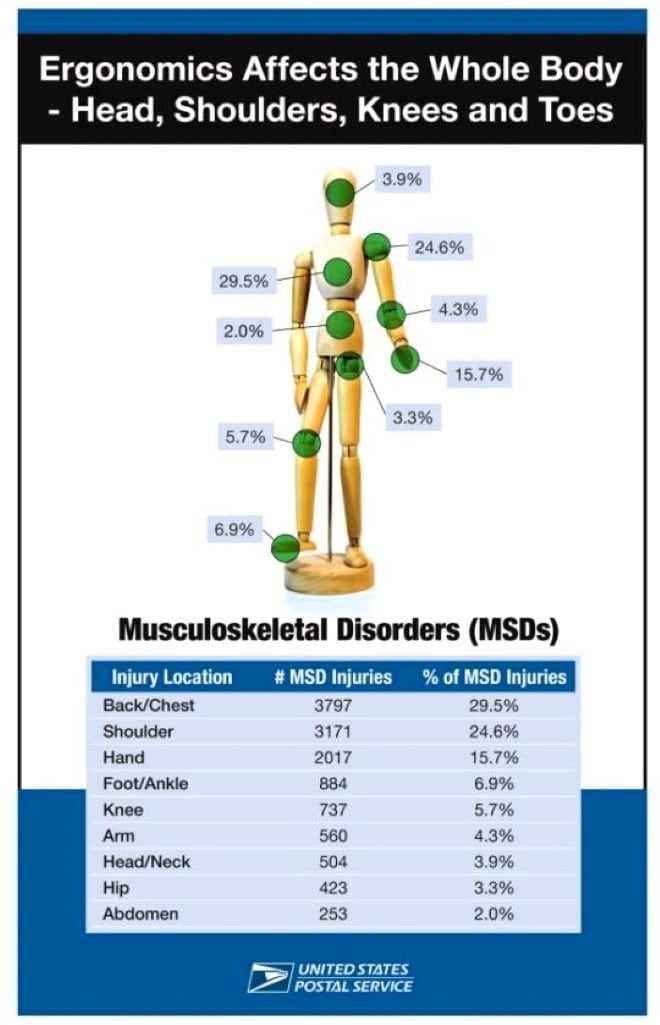
Ergonomics: Work Smarter, not Harder
The word ergonomics comes from the Greek word “ergon,” which means work, and “nomos,” which means laws. Essentially, ergonomics is defined as the laws that govern work or can be described as the science of work. There are three main subsets of ergonomics that apply to the science of work: physical, cognitive, and organizational ergonomics. You might not realize it, but all these aspects of ergonomics are at play within Postal Service™ work environments, operations, and organizations.
Physical Ergonomics
Physical ergonomics considers the human body as it relates to the musculoskeletal system and physical activity. The most common areas of consideration for physical ergonomics are the consequences of repetitive motion, forces on the body, and working postures in jobs within postal operations, such as handling and moving the mail. With the increased emphasis on package delivery, employees should learn how to reduce the potential risk of injury from lifting and the impact of wear-and-tear on the body in the workplace. For physical ergonomics, what primarily comes into play is the safety and health of the worker.
Simply described, physical ergonomics is “fitting the task to the person” or making manual work less difficult and safer. Some examples of physical ergonomics principles commonly applied in postal facilities include:
- Sizing up the load, testing the weight, and assessing the shape and position of a package. If the load is too heavy or awkward to move alone, use a hand cart or do a team lift. Team lifting is a technique used whenever handling or transferring anything that is too large for one person. During a team lift, designate a person to lead the lift, lift at the same time, keep the load level, and slowly unload together. Working together will make the job easier, faster, and less dangerous.
- Lifting correctly by keeping the load as close to the body as possible. Maintain a neutral back posture to avoid bending, while keeping your chin up and lifting with your legs. Let your legs do the work by using your strong thigh muscles to lift, rather than your weaker back. Don’t twist your body if you need to turn. If possible, place your feet shoulder-width apart and straddle the load. Move your feet instead of your trunk.
- Modifying the workspace to reduce the reach or using a tool such as a reach extender.
- Raising work items with equipment like a pallet lifter or container tilter to reduce bending and overreaching when unloading packages or mail trays.
- Adjusting computer workstations to ensure monitors are at the right height for optimal viewing and the keyboard and mouse are positioned correctly for height and reach.
- Improving work practices and techniques or applying administrative controls, such as job rotation.
Cognitive Ergonomics
Cognitive ergonomics considers mental processes, such as perception, attention, memory, reasoning, decision-making, learning, and motor response as they impact interactions with mechanical or visual systems. In other words, cognitive ergonomics focuses on the brain and how it interacts with the environment.
The system must be designed keeping in mind the human brain’s abilities and limitations to ensure optimum safety and function. Examples of this aspect used within the Postal Service to make systems “user-friendly” include:
- Skills training.
- Reducing mental workload by limiting the number of inputs and outputs monitored.
- Improving the decision-making process with better controls and displays.
- Reducing fatigue and workload through optimization of mail processing equipment.
- Training as it relates to human-system design in operations and maintenance, such as with robotics systems.
Organizational Ergonomics
Organizational ergonomics considers the structures, policies, and processes of an organization. The goal of organizational ergonomics is to optimize the system for all individuals within the organization.
Organizational ergonomics takes into consideration the challenges and consequences of technology on the person, process, and organization. Examples of applied organizational ergonomics within the Postal Service include:
- Teamwork.
- Communication.
- Quality management.
- Design of working times/duration.
- Work design and flow.
- Telework.
- Participatory design.
- Collaborative work.
Each aspect of physical, cognitive, and organizational ergonomics can be applied individually, but greater success can be achieved when they are applied together for improved safety and injury reduction, as well as optimal equipment and organizational engagement.
For more information about ergonomics, check out the following resources:
- Ergonomic Safety talks module in the HERO system under “My Learning.”
- For a printable version of the Ergonomics poster on page 5, see “Posters” in the Safety and Health Management Tool Library.
- Safety and Health videos are available in MyHR under “Safety Awareness Programs.”
- For additional ergonomics resources, visit MyHR Workplace Safety.
- Occupational Safety and Health Administration (OSHA): osha.gov/ergonomics.
- Centers for Disease Control (CDC): cdc.gov/niosh/topics/ergonomics.
- National Safety Council: nsc.org/workplace/safety-topics/msd.
Postal Bulletin – February 8, 2024

Source: USPS

